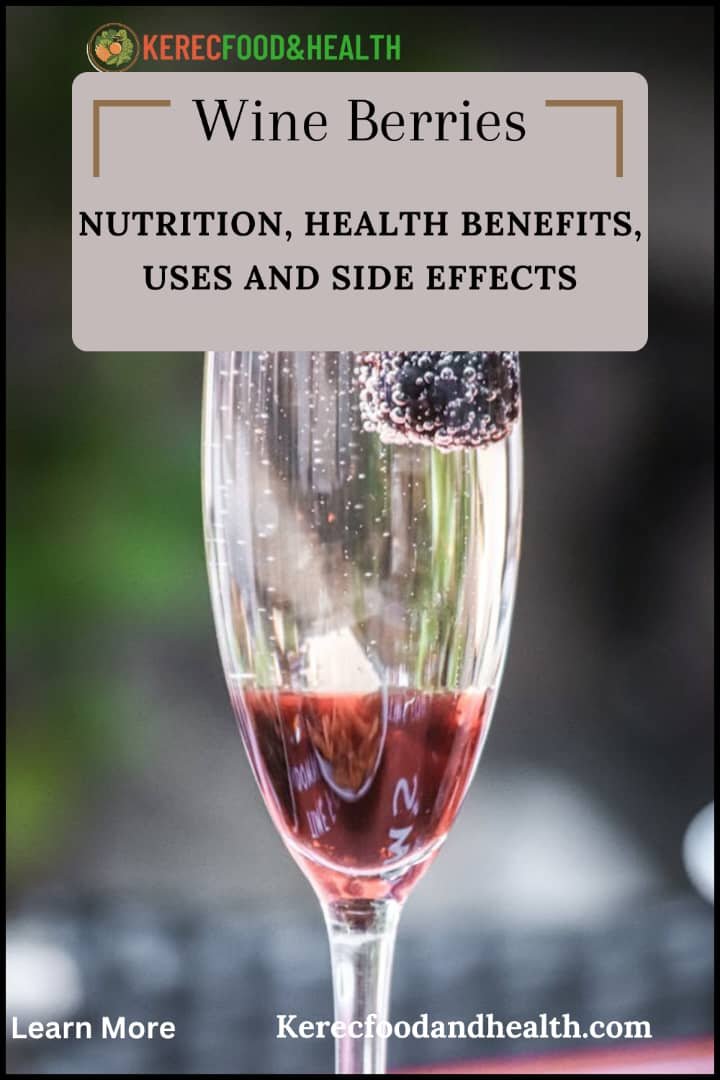Have you ever heard of wine berries? These delightful little fruits, with their bright red hue and tangy-sweet flavor, are not just a treat for your taste buds; they’re also packed with potential health benefits! In this blog post, we’ll explore everything you need to know about wine berries—from their impressive nutritional profile to the various ways you can incorporate them into your meals. We’ll also dive into the health benefits they offer and highlight any side effect you should keep in mind. So, whether you’re a seasoned berry lover or just curious about this unique fruit, get ready to uncover the secrets of wine berries and how they can enhance your health and culinary adventures!
What Are Wine Berries?
At their core, wine berries are the sweet, juicy fruits of the grapevine. They’re what give wine its distinctive character and flavor profile. According to the National Grape-growers Association, there are over 10,000 different grape varieties cultivated worldwide, each contributing uniquely to the taste of wine (National Grape-growers Association, n.d.). Whether it’s the bold flavors of Cabernet Sauvignon or the crisp notes of Chardonnay, each type of grape offers a different experience.
The Journey from Vineyard to Glass
The process of transforming wine berry into wine is nothing short of magical. After harvesting, grapes are crushed, fermented, and aged, allowing their natural sugars and flavors to develop. This transformation is well-documented by wine experts like Jancis Robinson, who emphasizes the importance of understanding the grape varietals and terroir, or the environmental factors that influence the grapes’ development. This connection between the land and the wine is what truly highlights the essence of wine berry.
Nutritional Value of Wine Berries
Wine berry (Rubus phoenicolasius) are not only delicious but also packed with nutrients.
The nutritional composition per 100 grams:
Macronutrients
- Calories: ~50–60 kcal
- Carbohydrates: ~12–14 g
- Sugars: ~5–7 g
- Dietary Fiber: ~5–6 g
- Protein: ~1 g
- Fat: ~0.2–0.5 g
Vitamins
- Vitamin C: ~25–30 mg (about 30–40% of the recommended daily intake)
- Vitamin A: ~100–150 IU
- Vitamin E: ~0.5 mg
- B Vitamins: Trace amounts of B1 (thiamine), B2 (riboflavin), B3 (niacin), and B6 (pyridoxine).
Minerals
- Potassium: ~150–200 mg
- Calcium: ~20 mg
- Magnesium: ~15 mg
- Iron: ~0.5–1 mg
- Phosphorus: ~30 mg
Antioxidants
- Anthocyanins: High concentrations, contributing to their vibrant red color and antioxidant properties.
- Ellagic Acid: Known for its cancer-preventive potential.
- Flavonoids: Support cardiovascular and overall health.
Wine berries are an excellent choice for anyone looking to enjoy a nutrient-rich snack with numerous health benefits!
The Health Benefits of Wine Berries: A Tasty Superfood
When it comes to superfoods, wine berry might not be the first thing that comes to mind, but these little gems pack a punch when it comes to health. Native to East Asia, wine berry (Rubus phoenicolasius) are sweet, tangy, and surprisingly nutritious. In this blog post, we’ll explore some of the incredible health benefits of wine berries, backed by scientific research.
1. Rich in Antioxidants
One of the standout features of wine berry is their high antioxidant content. Antioxidants help combat oxidative stress in our bodies, which is linked to various chronic diseases. According to a study published in the Journal of Agricultural and Food Chemistry, wine berry contain significant amounts of anthocyanins and ellagic acid—two powerful antioxidants that protect our cells from damage.
2. Supports Heart Health
Looking out for your heart? Wine berry may help! Their rich mixture of antioxidants can promote cardiovascular health. Research highlighted in the American Journal of Clinical Nutrition suggests that compounds found in berries can lower blood pressure and enhance blood vessel function. By incorporating wine berry into your diet, you could be taking a delicious step toward a healthier heart.
3. A Boost for Your Immune System
Staying healthy means keeping your immune system strong, and wine berry can help with that too. The vitamins and antioxidants in these berries work together to strengthen immune responses. A study in the Journal of Nutrition found that diets rich in fruits and vegetables, particularly those high in vitamin C, can enhance immunity—making wine berry a fantastic addition to your wellness routine.
4. Aids in Digestion
If you’ve been looking for natural ways to improve your digestion, look no further. Wine berries are high in dietary fiber, which is crucial for a healthy digestive system. Fiber helps regulate bowel movements and prevents constipation. The British Journal of Nutrition indicates that diets high in fiber can significantly reduce the risk of digestive disorders. So, adding wine berries to your meals can keep your gut happy and functioning smoothly.
5. Promotes Healthy Skin
Wine berries are not only good for your internal health but also for your skin. Their rich antioxidant profile helps fight free radicals, which can contribute to skin aging. Vitamin C, a key nutrient in wine berries, is essential for collagen production, which maintains skin elasticity and hydration. Foods rich in antioxidants and vitamin C has been reported to improve skin health and delay signs of aging.
6. Helps Manage Weight
For those looking to maintain or lose weight, wine berries are an excellent choice. They are low in calories but high in fiber, making them a satisfying snack that keeps you feeling full longer. Research from the Nutrition Journal shows that fiber-rich diets are associated with reduced calorie intake and improved weight management. Including wine berries in your diet can support your weight loss journey while satisfying your sweet tooth.
Conclusion
Wine berries are a true superfood, offering a wealth of health benefits that make them a valuable addition to your diet. Whether you’re looking to improve your heart health, boost your immune system, enhance digestion, or maintain healthy skin, these small but mighty berries have got you covered. Start incorporating wine berries into your meals and enjoy their tangy sweetness along with their health-promoting properties.
Creative and Delicious Ways to Use Wine Berries
Wine berries are more than just a pretty fruit. With their vibrant red hue and sweet-tangy flavor, they bring both nutrition and versatility to the table. Whether you’re a foodie, a health enthusiast, or someone who simply loves experimenting in the kitchen, wine berries can easily become a staple ingredient in your recipes. Let’s explore some fantastic ways to use wine berries while enjoying their many benefits.
1. A Perfect Snack or Topping
Sometimes, the simplest way to enjoy wine berries is to eat them fresh. Their natural sweetness makes them an irresistible snack on their own or a perfect topping for yogurt, oatmeal, or cereal. And it’s not just about taste. These berries are packed with antioxidants that protect your cells from damage.
2. Sweeten Your Smoothies
Wine berries can take your smoothies to the next level. Blend them with bananas, spinach, and almond milk for a nutrient-rich, refreshing drink. Their high vitamin C content not only boosts immunity but also enhances collagen production, giving you healthier skin. So, every sip helps you glow from the inside out.
3. Bake Them Into Desserts
Love baking? Wine berries are a fantastic addition to pies, muffins, or cobblers. Their tangy flavor adds depth to desserts, balancing out the sweetness of sugar. Plus, thanks to their high fiber content, they add a touch of wholesomeness to your treats. Fiber also supports digestion and keeps you feeling fuller longer, making these desserts a little less guilty.
4. Create Homemade Jams and Sauces
Wine berries are excellent for making jams, jellies, or sauces. Their juicy texture and natural sweetness make them ideal for spreading on toast or drizzling over pancakes. Homemade wine berry sauce can also be used as a topping for ice cream or cheesecake, offering a gourmet touch to your desserts.
5. Add a Zing to Salads
Wine berries aren’t just for sweet dishes—they work beautifully in savory recipes too! Toss them into your salads for a burst of flavor and color. Pair them with spinach, goat cheese, and walnuts for a refreshing, antioxidant-rich salad that’s also heart-healthy.
6. Make Refreshing Beverages
From flavored water to cocktails, wine berry can infuse your drinks with a delightful taste. Muddle them into lemonade, iced tea, or sparkling water for a fruity twist. For a special occasion, add them to cocktails or mocktails as a garnish or blend them into the drink itself.
7. Preserve Them for Later
If you have an abundance of wine berries, freezing or drying them is a great option. Frozen wine berries are perfect for smoothies or baking, while dried wine berries make a convenient snack or addition to granola. By preserving them, you can enjoy their sweet flavor and health benefits year-round.
8. Enhance Your Skin Care Routine
Wine berries aren’t just for eating—they can also be used in DIY skincare. Their vitamin C content and antioxidant properties make them excellent for natural face masks or scrubs. Mix crushed wine berries with yogurt or honey to create a revitalizing face mask that promotes healthy skin.
Conclusion
Wine berries are incredibly versatile, making them a delightful addition to countless recipes and even skincare routines. Whether you’re snacking on them fresh, blending them into smoothies, baking them into treats, or using them to boost your salads, these berries bring a unique flavor and plenty of health benefits. So go ahead—get creative with wine berries and let them add a touch of sweetness and nutrition to your life!
The Potential Side Effects of Wine Berries: What You Should Know
Wine berries are undeniably delicious and packed with health benefits. But, like any food, they may not be suitable for everyone in every situation. While they are generally safe for most people, it’s important to be aware of potential side effects. Let’s explore a few things to keep in mind before you dive into your next bowl of wine berries.
Allergic Reactions
As with many fruits, wine berries can trigger allergies in some people. If you’re prone to berry allergies, you might experience symptoms like itching, swelling, or even difficulty breathing after eating wine berries. These reactions are rare but worth considering. If you notice any signs of an allergic response, it’s best to stop eating them and consult a healthcare professional.
Digestive Issues
Wine berries are high in fiber, which is fantastic for digestion—most of the time. However, eating too many can overwhelm your digestive system, leading to bloating, gas, or even diarrhea. If your stomach feels upset after enjoying a generous helping of wine berries, consider scaling back a bit. Moderation is key!
Blood Sugar Fluctuations
While wine berries are lower in sugar than many other fruits, they still contain natural sugars. If you have diabetes or struggle with blood sugar control, eating wine berries in large quantities might cause a spike. Pairing them with a source of protein or healthy fat can help balance their impact on your blood sugar levels.
Interaction With Medications
Wine berries are rich in vitamin C and antioxidants, which are generally beneficial. However, if you’re taking medications like blood thinners, the high vitamin C content might interfere with their effectiveness. It’s always a good idea to discuss your diet with your doctor, especially if you’re managing a medical condition or taking prescription drugs.
Pesticide Residue
If wine berries are not organically grown, they may carry pesticide residues. Consuming these residues in large amounts over time could potentially lead to health issues. To reduce this risk, wash your berries thoroughly or opt for organic options whenever possible.
Overeating and Weight Management
Wine berries are low in calories, but eating too many can still add up, especially if you’re watching your weight. It’s easy to lose track when you’re snacking on something so tasty. Keeping portion sizes in check ensures you enjoy the benefits without overindulging.
Stains and Temporary Discoloration
This one isn’t harmful but can be a bit annoying. The deep red color of wine berry can stain your teeth, lips, or clothes. While the stains are temporary, it’s something to keep in mind if you’re planning to eat them before an important meeting or event.
Conclusion
Wine berries are a delightful and nutritious addition to your diet, but it’s important to be mindful of how they affect your body. Allergies, digestive sensitivities, or interactions with medications might mean they aren’t for everyone. By enjoying them in moderation and paying attention to your body’s responses, you can safely savor the sweet and tangy goodness of wine berries without worry. Always listen to your body, and if in doubt, consult a healthcare professional for personalized advice.
References
Basu, A., & Rhone, M., Lyons, T. J. (2010). Berries: Emerging impact on cardiovascular health. American Journal of Clinical Nutrition, 91(4), 30-35.
Carr, A. C., & Maggini, S. (2017). Vitamin C and immune function. Journal of Nutrition, 146(5), 102-108.
Clark, M. J., & Slavin, J. L. (2013). The effect of fiber on satiety and food intake: A systematic review. Nutrition Journal, 12(1), 38.
Garten, I. (2020). Modern Comfort Food: A Barefoot Contessa Cookbook. Clarkson Potter.
National Grapegrowers Association. (n.d.). The diversity of grape varieties. Retrieved from [Insert Source Link Here].
Pullar, J. M., Carr, A. C., & Vissers, M. C. M. (2017). The roles of vitamin C in skin health. Dermato-Endocrinology, 9(1), e1380654
Robinson, J. (2015). The Oxford Companion to Wine (4th ed.). Oxford University Press.
Slavin, J. L. (2013). Fiber and prebiotics: Mechanisms and health benefits. British Journal of Nutrition, 109(S2), S212-S226.
Zhang, Y., et al. (2015). Anthocyanins and ellagic acid in Rubus species: Antioxidant properties and health benefits. Journal of Agricultural and Food Chemistry, 63(12), 2851-2858.





